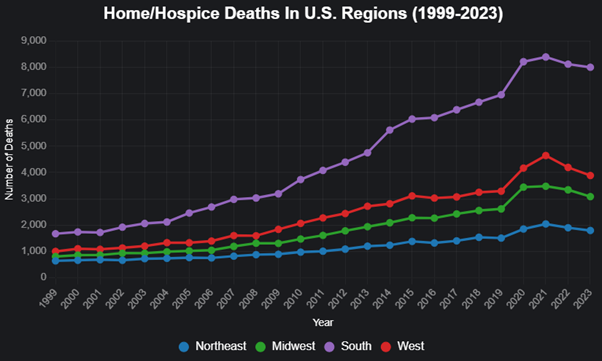Sunday Poster Session
Category: Liver
P1562 - Where Are Patients with Cirrhosis Dying?: A 24-Year CDC-WONDER Analysis
Sunday, October 26, 2025
3:30 PM - 7:00 PM PDT
Location: Exhibit Hall

Aalam Sohal, MD
Creighton University School of Medicine
Phoenix, AZ
Presenting Author(s)
Aalam Sohal, MD1, Sampada Bhasker, MBBS2, Mehul Solanki, 3, Carol Singh, MBBS4, Sunny Sandhu, MD5
1Creighton University School of Medicine, Phoenix, AZ; 2Punjab Institute of Medical Sciences, Jalandhar, Punjab, India; 3Maulana Azad Medical College, Delhi, Delhi, India; 4Dayanand Medical College and Hospital, New Jersey, NJ; 5Stanford University, Palo Alto, CA
Introduction: Cirrhosis is a major contributor to morbidity and mortality in the United States, often involving recurrent hospitalizations, leading to financial and psychosocial burden on patients and healthcare systems. Palliative care is increasingly recognized in the management of chronic diseases as a measure to improve quality of life, as well as to facilitate advanced care planning. This analysis examines patterns in cirrhosis-related mortality across the United States over 24 years (1999–2023), with a focus on location of death to assess the impact of palliative care.
Methods: Information was obtained from the CDC WONDER database for the years 1999 through 2023 of individuals aged ≥25 years using ICD codes for cirrhosis. Data was stratified by place of death and classified as home/hospice, medical facility, nursing home, or other. The population was divided by age groups, gender, race/ethnicity, and census regions. Age-adjusted mortality rates (AAMRs) per 100,000 individuals aged ≥25 years were extracted for the years 1999 through 2023.
Results: Between 1999 and 2023, a total of 755,206 deaths were attributed to cirrhosis. Over the study period, there was a significant increase in cirrhosis-related deaths. Between 1999 and 2023, the overall AAMR increased from 11.7 to 17.4 per 100,000, with an AAPC of 1.7 (95% CI: 1.51–1.82, p < 0.001). Out of the total cirrhosis-related deaths, 246,568(32.6%) occurred in home/hospice,394,447(52.2%) in medical facilities, and 83,497(11.1%) in nursing homes. The percentage of patients dying at home/hospice was 19.2% in 1999 to 36.7% in 2023. The highest number of home/hospice deaths was observed in Whites (90.6%), males (64.6%), residents of the South (45.8%), and in the age group 45-64 years (48.4%). The percentage of residents in the Northeast region dying at home or in hospice care increased from 16.6% to 30.2%; in the Midwest, from 19.0% to 34.9%; in the South, from 21.1% to 41.7%; and in the West, from 21.6% to 33.1%.
Discussion: Medical and nursing facilities account for the majority of cirrhosis-related deaths, highlighting a persistent reliance on institutional care at the end of life. However, there has been a slow but steady increase in home and hospice deaths over the study period, suggesting an increased role of palliative and home hospice services. Further research on patient and family-reported outcomes is necessary, with attention to interventions that support patient-centered care and reduce reliance on institutional care at end-of-life.

Figure: Figure 1- Home/hospice Deaths, stratifed by various US Regions

Figure: Figure 2- Trends in Deaths of Cirrhosis, stratified by location of death
Disclosures:
Aalam Sohal indicated no relevant financial relationships.
Sampada Bhasker indicated no relevant financial relationships.
Mehul Solanki indicated no relevant financial relationships.
Carol Singh indicated no relevant financial relationships.
Sunny Sandhu indicated no relevant financial relationships.
Aalam Sohal, MD1, Sampada Bhasker, MBBS2, Mehul Solanki, 3, Carol Singh, MBBS4, Sunny Sandhu, MD5. P1562 - Where Are Patients with Cirrhosis Dying?: A 24-Year CDC-WONDER Analysis, ACG 2025 Annual Scientific Meeting Abstracts. Phoenix, AZ: American College of Gastroenterology.
1Creighton University School of Medicine, Phoenix, AZ; 2Punjab Institute of Medical Sciences, Jalandhar, Punjab, India; 3Maulana Azad Medical College, Delhi, Delhi, India; 4Dayanand Medical College and Hospital, New Jersey, NJ; 5Stanford University, Palo Alto, CA
Introduction: Cirrhosis is a major contributor to morbidity and mortality in the United States, often involving recurrent hospitalizations, leading to financial and psychosocial burden on patients and healthcare systems. Palliative care is increasingly recognized in the management of chronic diseases as a measure to improve quality of life, as well as to facilitate advanced care planning. This analysis examines patterns in cirrhosis-related mortality across the United States over 24 years (1999–2023), with a focus on location of death to assess the impact of palliative care.
Methods: Information was obtained from the CDC WONDER database for the years 1999 through 2023 of individuals aged ≥25 years using ICD codes for cirrhosis. Data was stratified by place of death and classified as home/hospice, medical facility, nursing home, or other. The population was divided by age groups, gender, race/ethnicity, and census regions. Age-adjusted mortality rates (AAMRs) per 100,000 individuals aged ≥25 years were extracted for the years 1999 through 2023.
Results: Between 1999 and 2023, a total of 755,206 deaths were attributed to cirrhosis. Over the study period, there was a significant increase in cirrhosis-related deaths. Between 1999 and 2023, the overall AAMR increased from 11.7 to 17.4 per 100,000, with an AAPC of 1.7 (95% CI: 1.51–1.82, p < 0.001). Out of the total cirrhosis-related deaths, 246,568(32.6%) occurred in home/hospice,394,447(52.2%) in medical facilities, and 83,497(11.1%) in nursing homes. The percentage of patients dying at home/hospice was 19.2% in 1999 to 36.7% in 2023. The highest number of home/hospice deaths was observed in Whites (90.6%), males (64.6%), residents of the South (45.8%), and in the age group 45-64 years (48.4%). The percentage of residents in the Northeast region dying at home or in hospice care increased from 16.6% to 30.2%; in the Midwest, from 19.0% to 34.9%; in the South, from 21.1% to 41.7%; and in the West, from 21.6% to 33.1%.
Discussion: Medical and nursing facilities account for the majority of cirrhosis-related deaths, highlighting a persistent reliance on institutional care at the end of life. However, there has been a slow but steady increase in home and hospice deaths over the study period, suggesting an increased role of palliative and home hospice services. Further research on patient and family-reported outcomes is necessary, with attention to interventions that support patient-centered care and reduce reliance on institutional care at end-of-life.

Figure: Figure 1- Home/hospice Deaths, stratifed by various US Regions

Figure: Figure 2- Trends in Deaths of Cirrhosis, stratified by location of death
Disclosures:
Aalam Sohal indicated no relevant financial relationships.
Sampada Bhasker indicated no relevant financial relationships.
Mehul Solanki indicated no relevant financial relationships.
Carol Singh indicated no relevant financial relationships.
Sunny Sandhu indicated no relevant financial relationships.
Aalam Sohal, MD1, Sampada Bhasker, MBBS2, Mehul Solanki, 3, Carol Singh, MBBS4, Sunny Sandhu, MD5. P1562 - Where Are Patients with Cirrhosis Dying?: A 24-Year CDC-WONDER Analysis, ACG 2025 Annual Scientific Meeting Abstracts. Phoenix, AZ: American College of Gastroenterology.
